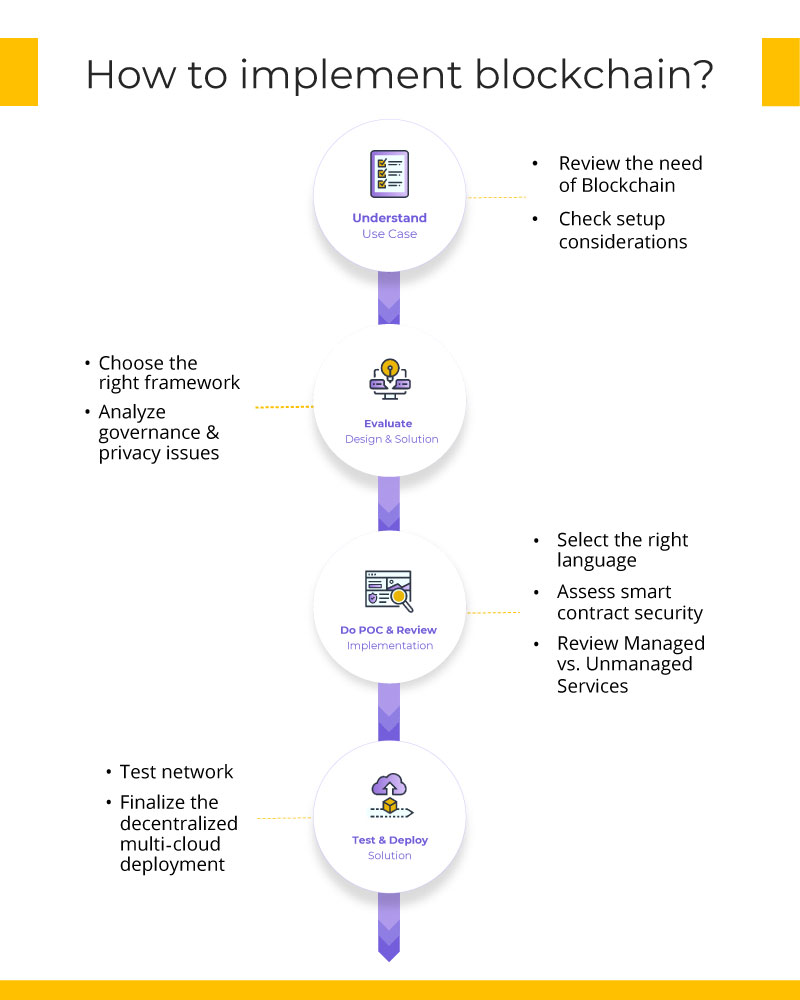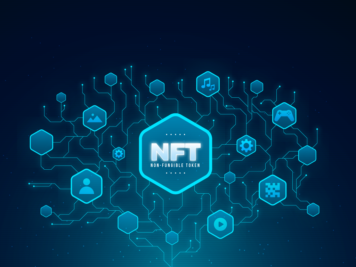60 percent. That’s the share of Fortune 500 companies that have adopted blockchain in some form, according to 2025 Coinbase survey . The technology has gone mainstream at the top. But if you scroll down a bit the startups, scale-ups, even mid-sized companies for them the idea of “blockchain implementation” still triggers more questions than answers. What’s missing isn’t intent—it’s clarity. Most teams struggle to connect the promise of decentralization with tangible business value, scalable architecture, and regulatory realities.
If you’re a startup founder, CTO, or innovation head wondering whether to jump into blockchain, this blog can guide you how you can implement blockchain the right way. This blog isn’t theory. Its implementation insight written on what we have learned from hard-won lessons while delivering solutions with companies like yours.
Before you integrate blockchain- Are you ready for it?
Start with the Problem, Not the Protocol. Successful implementation starts with asking: What’s the business problem we’re solving that needs trust, transparency, and tamper-proof data?
Use cases where blockchain adds undeniable value:
- Supply chain traceability (e.g., provenance of food, pharmaceuticals)
- Digital identity verification (e.g., KYC in fintech, student credentials in edtech)
- Smart contracts (e.g., automated insurance claims, royalty payments)
- Data integrity (e.g., healthcare records, audit logs in compliance-heavy sectors)
If your problem doesn’t need decentralization, blockchain may not be the answer—and that’s okay.
A successful blockchain implementation requires a good understanding of blockchain fundamentals, blockchain frameworks, platforms, limitations, benefits, and sufficient implementation experience. In order to avoid any implementation issue, there are a few aspects that should be kept in mind to ensure a successful outcome.
Things To Do Before Starting Your Blockchain Implementation
Although blockchain is gaining a favorable tailwind from enterprises of different sizes, ignoring its failure rate before implementing the technology would be a deadly mistake. Gartner’s 2019 report shows that only about 5% of the proof of concepts (POC) make it to the production stage and then 90% of them fail to survive beyond the first 2 years.
These statistics show how crucial it is for a company to question why do they need blockchain in the first place? You can always start with the following ones-
- Are transparency and traceability essential for me?
- Is decentralization needed for my solution?
- Are my processes going to consume less time after I implement the blockchain-based solution?
- Am I doing it for new sources of finance?
- What types and amounts of data do I want on my distributed ledger?
- Who all would be my network participants?
- How much control do I want to have over the stored data?
- What maximum scalability is expected?
If you are still up with your plan to move forward with blockchain implementation, then you should keep these possible issues in check:
- The financial aspect
People often misunderstand Blockchain’s economics and how they create a long-term monetization plan with it. Blockchain’s value depends on its users just like social media platforms. Therefore, before implementing blockchain, businesses should learn more about the network effects of use cases and how to line them up. - Governance issues
Since blockchain requires consensus achieved between users and the consensus accomplished by validators, a proper governance structure is particularly important. A lot of early consortia failed just because they did not have a proper governance structure.
- No proper regulatory clarity
This is one problem that is haunting all the emerging technologies. Technologies like blockchain and edge computing are evolving so fast that maintaining simultaneous regulations for each with clarity has become difficult. However, the legal validity of identities on blockchain or transactions executed by smart contracts requires a structured regulatory framework.
- Database mentality
A lot of businesses are looking at blockchain as a traditional database. But blockchain can store only a finite amount of data and that too, in the ledger format. So, to make a decentralized application, you need proper architecture.
- Lack of experts
A successful blockchain implementation requires knowledge of programming languages, incentive mechanisms, smart contracts, governance, cryptography, and tokenomics. Such a combination of diverse skillset is rare in developers, which is why you need to get the right team first for the blockchain implementation.
- Legacy system issues
Traditional and distributed systems function differently. Also, a lot of sectors like healthcare require adherence to compliances. Factors like these make seamless integration of blockchain with an existing framework quite difficult.
- Improper KPIs
Decentralized platforms work with stakeholders from both inside and outside. In such cases, if Key Performance Indicators (KPIs) like transaction cost, user experience, throughput, and others are not properly defined, the system might collapse.
Steps to Implement Blockchain Successfully
The below infographic explains the process followed in most blockchain implementations.

Since the failure rate is high, you should adopt a measured approach. Follow these steps to implement blockchain successfully.
- Start with a use case
It is absolutely necessary to understand why you need blockchain technology for a better implementation of it. Start asking questions like-
- Why do I need it? What pain point will it solve?
- How is my business going to benefit from it? Who will use it?
- What would be my targets and objectives once I implement it?
To know in detail about the use cases of blockchain across various industries, check and understand the ways in which it can revolutionize the business.
- Create a Proof of Concept
Once you decide to go ahead, build a proof of concept first. The process will help you understand how valid this technology is for your business. For better direction, question yourself-
- What problems is my business trying to solve?
- What results do I want to secure?
- How can I use blockchain to transform my business?
- Select the right Blockchain.
There is no one blockchain platform for all the sectors. That is why finding out the one that suits your purpose is important. Ethereum, Quorum, Hyperledger Fabric, Corda, Stellar, and Open Chain are some of the popular platforms.
The decision is based on the requirements including the following:- Public or Private?
- How many users?
- Permissioned or Permissionless?
- What level of privacy is required?
- What use case is required? Smart contracts, Cryptos, NFTs?
- Need centralized or decentralized control on the network?
- Blockchain as a service
Businesses that are planning to implement blockchain can always adopt blockchain as a service from providers. In this way, they can reduce costs and development time for the infrastructure.
Companies can leverage the blockchain models and architectures of tech giants like- Amazon or AWS (Amazon Web Services)
- Microsoft’s Azure
- Oracle
- Building and testing solutions
For a new user, it is always better to opt for blockchain technologies that can be modified to meet business demands. To start with, they can check-- Technology breadth- whether it supports multichain and multiple platforms.
- Technology depth- whether it supports public or private blockchain.
- Create smart contracts to ensure you have your rules in place and you do not need an intermediary.
- If you have an app then test it on the test network to make sure it functions.
- Partner onboarding and integration
For an effective operation, you need to integrate your blockchain with a legacy system because a lot of your partners are still using a traditional platform. You still need them for your business and if you do not consider this linking part, then you will lose out on a lot of great opportunities. - Operate and manage
When you are ready to roll out, build the first block with all the features in it. After that, you should set up a secondary connection to streamline internal correspondence. The first step is to send information and the second is to set the grounds for others to receive the information. - Deployment
You now need to activate the blockchain on the blockchain network. For hybrid solutions that are a combination of on-chain and off-chain entities, you need to start with a cloud server.
- Select the right Blockchain.
- Select the right consensus protocol
There are, basically, five consensus protocols. You have to pick one for your business.- Proof of work- This protocol provides rewards to miners for solving tough equations.
- Proof of stake- In this one, the developer of the subsequent protocol gets picked up using various combinations of random qualities.
- Delegated proof of stake- This is more democratic in nature where the stakeholders elect the miner who would develop the next block.
- Byzantine fault tolerance (BFT)- In this protocol, components may fail and there would be imperfect information about a component’s failure only to build a consensus.
- Proof of weight- This protocol depends on a miner’s crypto balance.
- Build the ecosystem
When the number of stakeholders increases, build an ecosystem to improve understanding of the system and foster trust. It can be achieved by agreeing on-
- The terms of engagement
- Sharing of costs and rewards without bias.
- Governance mechanism
Avoid These Mistakes for Successful Blockchain Implementation
Adrian Leow, senior research director at Gartner, believes that blockchain is sliding down towards the “Trough of Disillusionment” and it is happening because people are losing interest in blockchain following the failure of their POCs. But businesses can definitely make their outcomes better if they avoid the following mistakes first during the implementation stage.
- Assuming blockchain as a mature technology
At present, there are too many platforms with fragmented services. Believing one of these would help you out with large-scale production that requires systems, security, and network management services would be wrong. For a better outcome, close monitoring of platform evolution and setting timelines accordingly are necessary.
- Confusing it with traditional database
Technology is still evolving and if you confuse it with a traditional database then you will be disheartened to find that it does not scale well.
- Expecting smooth interoperability
Most of the platforms are still in the development phase, hence, expecting your system to function well with others would be a huge mistake.
- Believing smart contracts are mature
Smart contracts are like business automation applications, which make blockchain dynamic. But its peer-to-peer network creates challenges regarding scalability and manageability.
- Relying on governance blindly
Unlike any traditional, centralized platform, public blockchains care little about human motivation or behaviors. This can trigger governance crises later and threaten the success of a blockchain project.
- Not supporting immutable data trail audits
Blockchain developers often get themselves stuck in building POCs to do what traditional database does. They do not use it to create immutable data audit trails with the help of its decentralized ledger.
- Taking protocols as business solutions
Like any other business solution, blockchain requires interoperability, interface, and business logic. Protocols do not provide everything, they just help blockchain operate in a needed way. People often think blockchain provides a complete application solution but that is far away from the truth.
Final Thoughts
Constant evolution and diversification have made blockchain a coveted technology, but they have also made it unreliable in terms of sustainability. In fact, blockchain implementation may need quite a few modifications before you start getting the results that you have envisioned for yourself.
That is why before you decide to adopt blockchain for your business, consider all its pros and cons because there would be a lot at stake for you. You should also be thoroughly aware of the blockchain technologies to leverage them better.
If you feel unsure, reach out to the experts to get a better know-how of the entire process, and build a POC first to understand its viability. We have dedicated blockchain teams that have enabled multiple businesses with successful blockchain implementation to drive business outcomes. Check our blockchain offerings.









